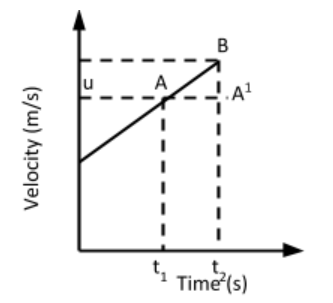
Derive \[{v^2} - {u^2} = 2as?\]
Answer
578.7k+ views
Hint: Concept of the area under speed and time graph gives distance and area covered under velocity-time graph gives the displacement.
Complete step by step solution: There are three equations of motion out of which this is the third one which is used to calculate initial velocity, final velocity, acceleration or displacement by the object. In order to derive the equation let us consider the velocity-time graph for a body having some non-zero initial velocity at time \[t{\text{ }} = {\text{ }}0\]

u is velocity at time $t_1$
v is velocity at time $t_2$
a is acceleration of the body along the straight line.
Displacement covered during the time interval \[{t_2} - {t_2} = {\text{ }}Area\]under AB i.e. $AB{t_1}{t_2} = s$
$s = \dfrac{1}{2} \times ({\text{sum of parallel sides)}} \times \,perpendicular\,dis\tan ce$
$S = \dfrac{1}{2}(v + u)t\,.....(i)$
There will be some situations when we don’t have any information about time and so it would be a good idea to derive an equation that does not have a t term. To do this we rearrange our first equation of motion $v = u + at$ to get
$t = \dfrac{{y - u}}{a}\,....(ii)$
And use this in equation (i) to replace t from equation (i), we get
$
s = \dfrac{1}{2}(v + u)\dfrac{{(v - u)}}{a} \\
as = \dfrac{1}{2}({v^2} - {u^2}) \\
\Rightarrow {v^2} - {u^2} = 2as \\
{v^2} = {u^2} + 2as \\
$
Which is the desired equation of motion.
Additional information: To solve problems using equations of motion, we should remember that
(1) If body starts from rest, it initial velocity = u = 0
(2) If we drop a body from some height, its Initial velocity = u = 0
(3) If body stops, its Final velocity = v = 0
(4) If body moves with uniform velocity, its Acceleration = a = 0
Note: Before applying the concept of the area under velocity and time graph, we will check if the v-t graph is linear or not and start with a non-zero value of velocity to derive the above expression.
Complete step by step solution: There are three equations of motion out of which this is the third one which is used to calculate initial velocity, final velocity, acceleration or displacement by the object. In order to derive the equation let us consider the velocity-time graph for a body having some non-zero initial velocity at time \[t{\text{ }} = {\text{ }}0\]

u is velocity at time $t_1$
v is velocity at time $t_2$
a is acceleration of the body along the straight line.
Displacement covered during the time interval \[{t_2} - {t_2} = {\text{ }}Area\]under AB i.e. $AB{t_1}{t_2} = s$
$s = \dfrac{1}{2} \times ({\text{sum of parallel sides)}} \times \,perpendicular\,dis\tan ce$
$S = \dfrac{1}{2}(v + u)t\,.....(i)$
There will be some situations when we don’t have any information about time and so it would be a good idea to derive an equation that does not have a t term. To do this we rearrange our first equation of motion $v = u + at$ to get
$t = \dfrac{{y - u}}{a}\,....(ii)$
And use this in equation (i) to replace t from equation (i), we get
$
s = \dfrac{1}{2}(v + u)\dfrac{{(v - u)}}{a} \\
as = \dfrac{1}{2}({v^2} - {u^2}) \\
\Rightarrow {v^2} - {u^2} = 2as \\
{v^2} = {u^2} + 2as \\
$
Which is the desired equation of motion.
Additional information: To solve problems using equations of motion, we should remember that
(1) If body starts from rest, it initial velocity = u = 0
(2) If we drop a body from some height, its Initial velocity = u = 0
(3) If body stops, its Final velocity = v = 0
(4) If body moves with uniform velocity, its Acceleration = a = 0
Note: Before applying the concept of the area under velocity and time graph, we will check if the v-t graph is linear or not and start with a non-zero value of velocity to derive the above expression.
Recently Updated Pages
Master Class 12 Economics: Engaging Questions & Answers for Success

Master Class 12 Maths: Engaging Questions & Answers for Success

Master Class 12 Biology: Engaging Questions & Answers for Success

Master Class 12 Physics: Engaging Questions & Answers for Success

Master Class 8 Maths: Engaging Questions & Answers for Success

Class 8 Question and Answer - Your Ultimate Solutions Guide

Trending doubts
What is meant by exothermic and endothermic reactions class 11 chemistry CBSE

Which animal has three hearts class 11 biology CBSE

10 examples of friction in our daily life

One Metric ton is equal to kg A 10000 B 1000 C 100 class 11 physics CBSE

1 Quintal is equal to a 110 kg b 10 kg c 100kg d 1000 class 11 physics CBSE

Difference Between Prokaryotic Cells and Eukaryotic Cells




